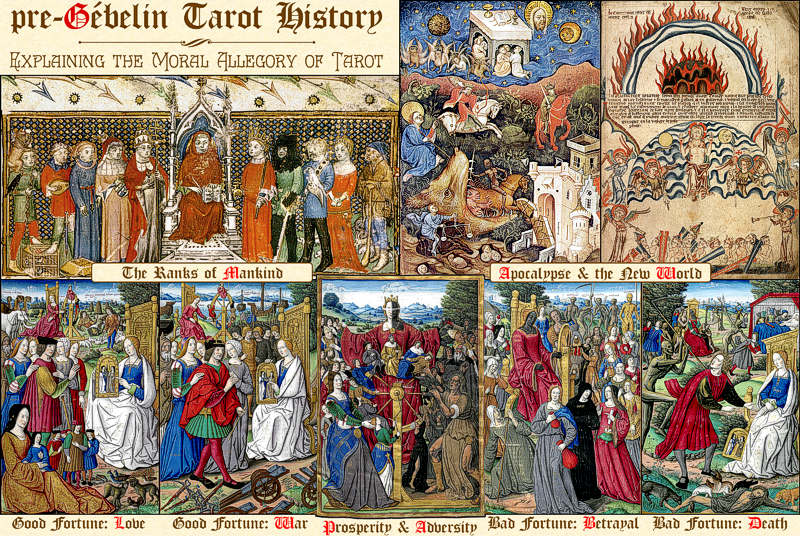Another spectacular example of the popess allegory is the great Battle of Lepanto painting by Vasari. (There are actually two, but we will ignore the other one.) This was pointed out to the Tarot community by Stuart Kaplan, who explained the import of it very well.
In medieval and Renaissance art, a female figure was often allegorical, whereas the male figure was used to represent a specific mythical or historical man. Thus, since Samson evoked the quality of great strength, the Strength card in several decks portrays a female figure with the attributes of Samson, a pillar and a lion skin. The Popess may represent the papacy itself, without reference to any particular pope or female leader. An example of a woman crowned with the papal tiara can be found in Giorgio Vasari’s picture commemorating the defeat of the Turks at the Battle of Lepanto. The alliance of Spain, Venice, and the papacy is represented by three women embracing, with the “popess” wearing the triple tiara and holding the two keys traditionally belonging to the pope.
Kaplan even included a small B&W picture of the relevant detail from the painting. The nature of personification allegory may have been news to the arrogant, ignorant, and flaky world of Tarot enthusiasts in 1986 when that was published. However, given that the first two volumes of Kaplan’s Encyclopedia of Tarot are as well-known and essential to the study of Tarot history as are Dummett and Moakley, no one who pretends to an interest in the subject has had an excuse since then. I have posted on it before, but here we will offer a little more detail and a much better image.


Shortly after the victory at the Battle of Lepanto, the renowned artist Giorgio Vasari was commissioned by Pope Pius V to commemorate the event in the Sala Regia in the Vatican, a “prominent location in the administrative heart of the papacy”. The following description is from Selling and Rejecting Politics in Early Modern Europe (2007), by Martin Gosman and Joop W. Koopmans.
Two large paintings in the Sala Regia, that were executed by Giorgio Vasari in 1572-1573, show episodes from the sea battle near Lepanto, in which the Christian navy crushed the Turkish fleet. This victory occurred on October 7, 1571, and consequently the paintings depict a very recent event. Giorgio Vasari carefully gathered as much information as he could, making his paintings a meticulous reconstruction of the course of the sea battle, of the geographical situation, the appearance of the ships and the military equipment of both armies, etc. Yet he also added allegorical elements, personifications of the Christian and Ottoman nations, and even the figures of Christ and his saints fighting against Muslim demons. Thus he not only made it clear who precisely were involved in this battle, but he also made it obvious that it was through divine assistance that the Christian army obtained the victory.
By showing the triumph of the Christians over the ‘infidels’, Vasari’s paintings were, of course, meant as propaganda of the ‘true’ Christian faith. This was highlighted by the visible presence of Christ and his saints, who take an active part in the battle and decisively chase the fallacious Turkish demons. References to biblical events, such as the defeat of the Egyptian Pharao and his army in the Red Sea, further emphasize the divine assistance, and make it clear that God will continue to help his people now and in the future, just as much as he had done in biblical times.
In creating this combination of an accurate visual report of what happened with an allegorical rendition of God’s eternal help and omnipotence, Giorgio Vasari had to be specific. Thus he could not avoid displaying that of all the ‘Christian’ nations in Europe (maybe Catholic is a better qualification in this case), only three had actually contributed to the Christian navy: Spain, Venice, and the Papal State, which were allied in the so-called Holy League. Personifications of these three nations consequently dominate on the foreground of the painting showing The Christian and the Turkish fleet on the eve of the Battle at Lepanto.
This is a different allegorical subject than the two sculptures detailed in the previous post. Here the popess represents the Papacy, while in the other two she represented the Church and Ecclesiastical Authority. But in all cases where a female figure wears the papal tiara, the subject is as emphatically Christian as one could even imagine. When the examples include allegories commissioned by popes to illustrate Christian subjects in the Vatican and especially at St. Peter’ Basilica, even Tarot enthusiasts should be able to grasp, perhaps dimly, the fact that this is Christian allegory.

Probably the greatest popess of all is the Triumph of the Church, by Peter Paul Rubens. There is a brief description at Web Gallery of Art, and a better one, albeit in Spanish, at the Prado page. The Wikimedia Commons page has the full-size image (3295 x 2717 pixels) from the Prado site.


The most striking popess in a manuscript may be Dame Doctryne from a copy of The Siege of Troy by John Lydgate. The Wheel of Fortune is held/turned by the Quene of Fortune. On the left, Dame Doctryne is accompanyied by two male figures, Holy Texte and Scrypture, and two female figures, Glose and Moralyzacion. They are shown helping people rise on Fortune's Wheel because, Lydgate says, scripture is about that which shall fall. Nobles, clerics, and commoners are shown falling. Once again, the popess is an essentially and emphatically Christian allegory.








No comments:
Post a Comment